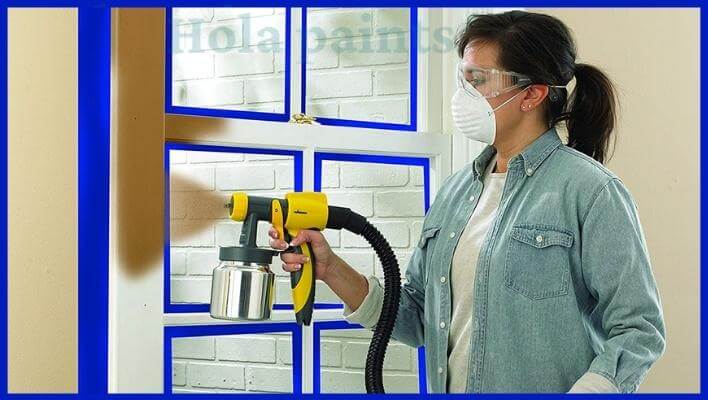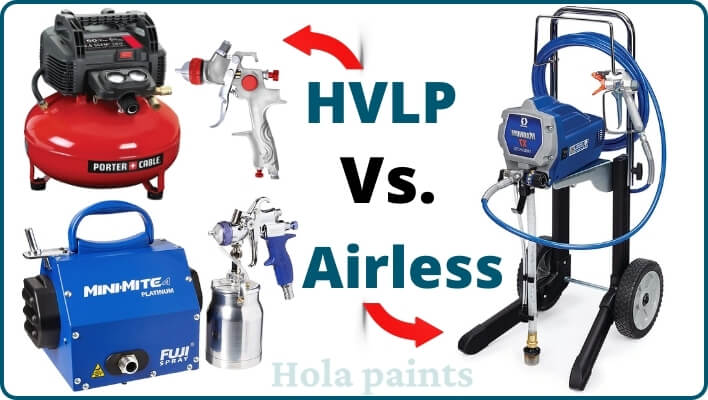Nothing quite transforms your bedroom or home like a fresh coat of paint. It is no longer necessary to use paint rollers, brushes, and other manual tools to accomplish the task. Today, painting is one of the easiest ways to update the indoor aesthetic, and it is also the most effective method. Using the right type of paint sprayer, you can achieve a stunning finish.
Particularly, Paint sprayers are efficient, highly productive painting tools and make the job quicker and more comfortable. Nevertheless, the key is to choose the most suitable paint sprayer for the painting job. Just like others, several types of paint guns are available, offering distinctive applications. You need to know the details of each sprayer while choosing the right one for yourself. This ultimate guide is all about types of spray guns (Wagner paint sprayer and Graco paint sprayer).
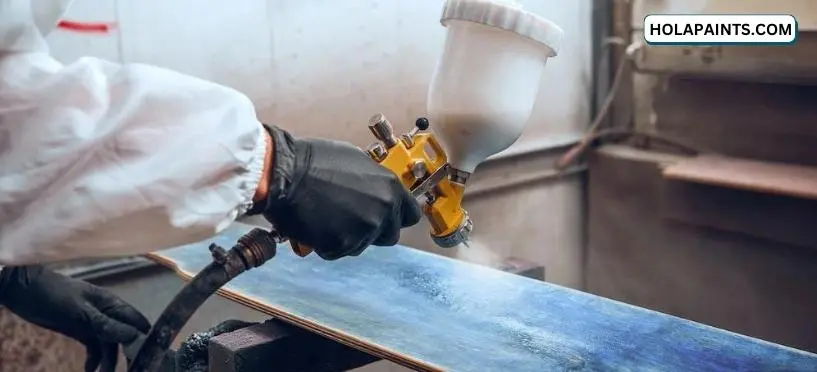
Table of Contents
- Different Types of Paint Sprayers
- 1. Airless Paint Sprayer
- You can use the airless paint sprayer for:
- 2. LVLP Spray Gun
- You can use the LVLP paint sprayer for:
- 3. HVLP Paint Guns
- You can use the HVLP paint sprayer for:
- 4. Pneumatic paint sprayer or Compressed Air Paint Sprayer
- You can use the Compressed Air Sprayer for:
- 5. Gravity Feed Paint Sprayer
- You can use the Gravity Feed Paint Sprayer for:
- Electric Paint Sprayer
- Cordless Paint Sprayer
- Electrostatic paint sprayer
- When should you use a paint sprayer?
- Large Surfaces:
- Smooth Finishes:
- Detailed Surfaces:
- Textured Surfaces:
- Efficiency:
- Professional Results:
- Multi-Color Projects:
- FAQs On Types of paint spray guns
- What are the 4 types of paint sprayers?
- What is the best kind of paint sprayer?
- What is the difference between air and airless paint sprayers?
- Final Words On Types of Paint Sprayers
Different Types of Paint Sprayers
Primarily, there are five different types of paint sprayers for various applications. Check out the details below with benefits, and everything important to paint sprayer types.
1. Airless Paint Sprayer

As the name suggests, the airless paint sprayer does not use air for painting. It utilizes a powerful electric pump to drive the paint via a small tip.
If you are working on a big painting project, airless paint sprayers are best for such applications. You can perform indoor and outdoor paint jobs with it easily.
As per my experience, the Graco X5 and X7 sprayers are an ideal choice for homeowners with its adjustable pressure control, making it easy to switch between different coatings for versatile painting. However, it requires a little effort to set up. So, you need some practice and you should know how to use it properly.
Otherwise, you will get overspray and non-uniform coverage.
These airless models enables you to cover a large area in a minimal time. However, not all the models offer this feature but the overall efficiency is better than manual painting work.
In short, it’s an affordable and reliable choice for DIYers and homeowners. You might be interested to check high-quality Airless sprayer for all your needs!
On the other hand, if you are in need of commercial airless sprayer then you should try Graco 390 or 395 which is known for its exceptional durability and high performance, making it a top choice for professionals.
You can use the airless paint sprayer for:
- Varnish or lacquer paint.
- Professional handyman or contractor painting jobs.
- Large painting projects.
PROS:
CONS:
2. LVLP Spray Gun
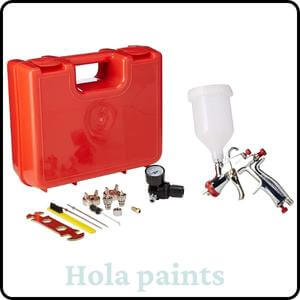
LVLP is the short form of “Low Volume and Low Pressure”. It works
with a minimum pressure of 10 PSI for working.
If you like DIY painting tasks, an LVLP spray gun might be your priority.
It is equipped with a small and basic type of air compressor. It is more economical than other compressor-based paint sprayers.
I have personally tested both the Sprayit 33000 and 33500 LVLP spray guns. If you’re not familiar with these models, you can check the differences between them.
If we talk about the size, they are more compact than other spray guns but can carry everything such as a reservoir, paint tank, etc. Due to this reason, they are most suitable for low-volume painting tasks.
They are highly portable and easy to carry anywhere. What we feel think about this type is that these spray gun can make you tired on bigger projects as the low pressure pump gives a low power. Also, it can’t pump thick paints and is good for thin paints due to low power.
You can use the LVLP paint sprayer for:
- Small painting projects.
- Indoors painting
- Fence and DIY painting.
PROS:
CONS:
3. HVLP Paint Guns
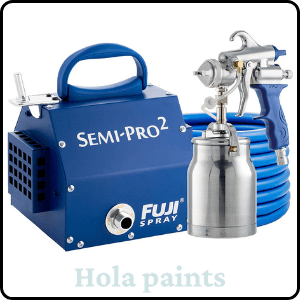
HVLP is the short form of “High Volume and Low Pressure” and offers precision painting. Such paint guns operate at low pressure and correspondingly eject the lower amount of paint.
For the paint to be pressurized, it utilizes air molecules. In short, they are easier to operate, control, and give high precision work.
On the other hand, HVLP paint guns are most suitable for thin painting jobs. You should not use it for volume painting jobs because it will take a long. It delivers the paint a bit slow but with precision and accuracy.
Let’s take an example here, Fuji Semi Pro is renowned for its professional-grade features, including a powerful turbine and precise control, perfect for homeowners.
On the other hand, the commercial-grade Fuji Q5 stands out for its quiet operation, exceptional atomization, and versatility in handling various finishes, making it a top choice for professionals.
Learn more about LVLP vs HVLP to select the best type of paint sprayer for your project needs.
You can use the HVLP paint sprayer for:
- Painting furniture, walls, cabinets, or doors.
- Painting molds and trims.
- Thin paints.
PROS:
CONS:
4. Pneumatic paint sprayer or Compressed Air Paint Sprayer
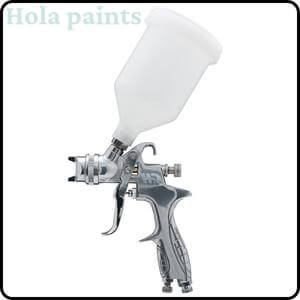
They are similar to the LVLP guns but an easier and ordinary type of sprayer. They work with the help of an air compressor connected via a pipe to force the paint through a nozzle.
They are pretty easy to operate and also very expensive. The primary issue is that you have to replace them after some time because they don’t offer consistency. The reason is lack of power.
They are popular for artisanal artwork, and the electric sprayer is its latest version. It’s applicable to multiple works such as painting cabinets, furniture, and art. If you want a simple solution, compressed air paint sprayers are best.
You can use the Compressed Air Sprayer for:
- Furniture, cabinets, and simple painting tasks.
- Highly economical paint solution.
PROS:
CONS:
5. Gravity Feed Paint Sprayer

Gravity feed paint sprayers are available in different sizes, replacements, and systems. They are called gravity feed because the overall system is adjustable and allows different coats on the surface.
As the system is attached to the top of the sprayer, they require low pressure for their operation.
In this way, you get a high-precision painting job with minimal cleanup and no overspray.
If you are looking for the types of spray guns for painting cars, a gravity feed paint sprayer might be your ideal choice.
It can be adjusted for large painting jobs, but professionals don’t recommend it. You get very clean and high-quality automotive paintwork with it.
It got a lot of praise due to its ability to clean coats. Due to its overall ability and useable for several applications.
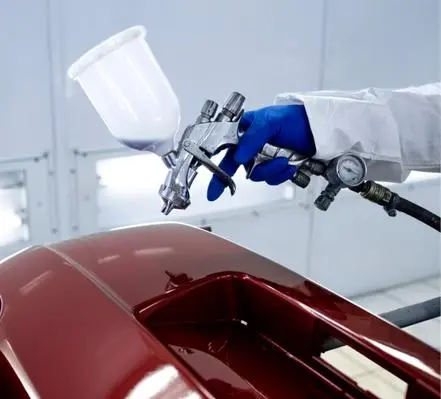
You can use the Gravity Feed Paint Sprayer for:
- Multiple applications.
- Specially used for car or automotive paint.
PROS:
CONS:
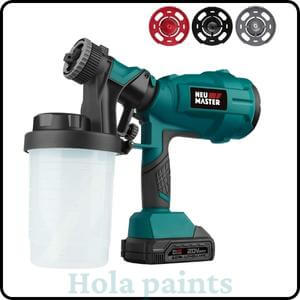
Electric Paint Sprayer
An electric paint sprayer such as Neu Master works with the help of electrical power. The compressor takes the electrical power and gives the paint accurate power.
Further, you get the clean paint finish according to your needs. The paint atomizer and high-pressure pump enable you to evenly coat any surface.
For house painting, an electric paint sprayer is a good tool. It is highly time-saving paint sprayer.
The work is easy, and the atomizer gets the paint with a pump powered by electricity.
Whether you are a professional, DIYer, or a beginner, you can use electric paint sprayers without any issues.
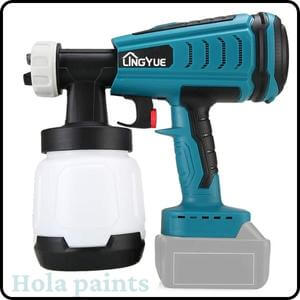
Cordless Paint Sprayer
Cordless paint sprayers work without any cord, and we use batteries to operate them.
If there is no power outlet available near you, you can still use the paint sprayer.
These types of sprayers are handy and straightforward to use. You get even spray, and it can cover bigger areas easily and quickly.
Cordless paint sprayers have several applications. You can read the top quality cordless sprayers review here.
You can enjoy the freedom of painting without cords when using the cordless Graco Ultra and Ultra max sprayers as I did. Plus, the ProConnect feature ensures that replacing the pump is a swift and hassle-free process, saving you precious time.
I also tested TCP Pro sprayer for painting my walls and cabinets. It is designed for professionals and more expensive cordless sprayer, featuring a reliable and consistent spray pattern, making it perfect for commercial use.
Electrostatic paint sprayer
Electrostatic paint sprayers utilize a unique process where paint particles are charged positively as they exit the sprayer. These charged particles are then attracted to a grounded object with a negative charge, resulting in an even and efficient coating. This method minimizes overspray, enhances paint transfer efficiency, and ensures a smooth finish.
Manufacturers widely adopt electrostatic spray painting due to its material-saving benefits, achieved through high transfer efficiency and uniform coating application.
PROS:
CONS:
When should you use a paint sprayer?
A paint sprayer can be a versatile tool that is useful in various painting scenarios. Here are some situations where using a paint sprayer might be particularly beneficial:
Large Surfaces:
Paint sprayers are efficient when covering large surfaces such as walls, ceilings, or fences. They can cover more area faster than brushes or rollers.
Smooth Finishes:
If you want a smooth and even finish without brush marks or roller stipple, a paint sprayer is a great choice. It atomizes the paint, creating a fine mist that lays down smoothly on the surface.
Detailed Surfaces:
Paint sprayers are excellent for intricate or detailed surfaces, such as cabinets, furniture, or molding. They reach corners and crevices effectively.
Textured Surfaces:
When dealing with textured surfaces like stucco or popcorn ceilings, a paint sprayer can provide more even coverage and reach into the texture better than a roller or brush.
Efficiency:
Paint sprayers are time-efficient, making them ideal for large projects or situations where you need to complete the job quickly. They can cover a large area with each pass, reducing the overall time spent on painting.
Professional Results:
For professional-looking results, especially in applications like automotive painting or finishing woodwork, a paint sprayer can provide a high-quality, factory-like finish.
Multi-Color Projects:
If you’re working on a project that involves multiple colors or intricate patterns, a paint sprayer allows for quick color changes and precise application.
However, paint sprayers have drawbacks. They can be messier than traditional methods, require more thorough preparation (masking and covering surfaces not to be painted), and may have a steeper learning curve. Additionally, they may not be cost-effective for small projects.
FAQs On Types of paint spray guns
What are the 4 types of paint sprayers?
Paint sprayers are categorized into four major types named as airless paint sprayers, compressed air paint sprayers, HVLP paint sprayers, and gravity feed paint sprayers. All these sprayers have different features, functionalities, and applications.
What is the best kind of paint sprayer?
Airless paint sprayers are the best kinds of sprayers due to their many significant features. They are quick, easy to use, and suitable for handling big painting projects. They don’t require the air compressor to work, which is a plus.
What is the difference between air and airless paint sprayers?
The difference between air and airless paint sprayer is the working principle. Air-based paint sprayers require air to work, while airless sprayers do not need air to work. Also, airless paint sprayers are more efficient than air-based sprayers.
Final Words On Types of Paint Sprayers
Keep in mind that the most suitable choice for your project hinges on your individual requirements. Always consider the size of the project, the type of paint or coating, types of paint sprayers, your level of experience and your comfort with the sprayer.
Selecting the right paint sprayer tailored to your specific needs will empower you to attain high-quality outcomes in your painting endeavors.

Jennifer Marie
Jennifer Marie is a general contractor with over the years of experience in home remodeling, DIY projects, and commercial painting projects. Her experience includes working with paint sprayers, painting tools, and other painting supplies. You can follow her on Facebook.

